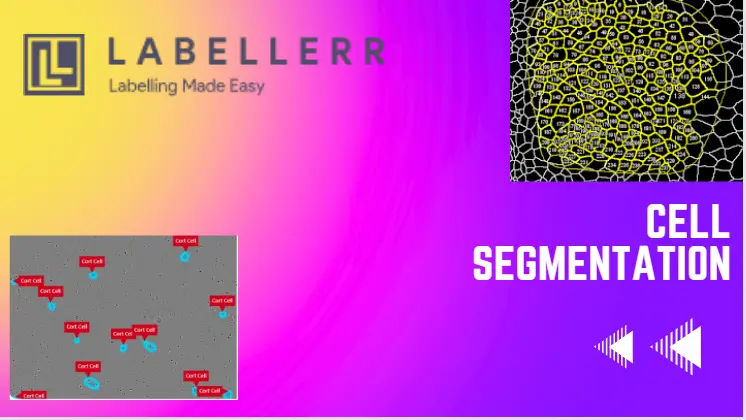Save Cost For Cell Segmentation Annotation with Labellerr

Introduction
In medical research, particularly in the study of neurological disorders like Alzheimer's disease and brain tumors, the ability to accurately segment individual neuronal cells from microscopic images is important for understanding disease progression and evaluating the treatment.
Traditional methods of manual cell segmentation are labor-intensive and time-consuming, hindering the pace of research and drug discovery efforts.
However, with the advancements of Computer Vision technology, there is a growing opportunity to automate the process of cell segmentation, allowing researchers to analyze cellular structures more efficiently and accurately.
Computer Vision plays an important role in cell segmentation by providing algorithms and techniques to automatically identify and delineate individual cells within microscopic images.
Labellerr emerges as a valuable tool, offering advanced annotation capabilities to facilitate the annotation of cellular structures for Computer Vision models.
Challenge
Neurological disorders, including neurodegenerative diseases such as Alzheimer's and brain tumors, present a significant challenge in quantifying treatment response and disease progression.
In cell segmentation, we are essentially annotating individual cells in a microscopic image.
This process separates each cell from its neighbors and the background, allowing researchers to analyze their size, shape, and other features.
This information is crucial for understanding cellular function, diagnosing diseases, and developing new treatments.
While light microscopy provides an accessible method for examining neuronal cells, accurately segmenting individual cells in microscopic images remains a difficult task.
The complex and overlapping nature of cells, along with variations in staining and imaging conditions, pose challenges for traditional segmentation methods.
Moreover, the large volume of microscopic images generated in neuroscience research necessitates automated solutions for cell segmentation to handle large datasets efficiently.
Solution: Labellerr's Role in Cell Segmentation

Cost Savings
Labellerr offers significant cost savings in cell segmentation tasks by streamlining the annotation process and reducing the need for manual labor.
With Labellerr's automated annotation capabilities, researchers can annotate cellular structures more efficiently, minimizing labor costs and accelerating research efforts.
Additionally, Labellerr's cost-effective pricing model ensures that organizations can achieve their research objectives within budgetary constraints, maximizing cost savings without compromising on quality.
Intuitive Interface
Labellerr provides an intuitive user interface designed to simplify the annotation process for cell segmentation tasks.
Its user-friendly design and navigation tools enable researchers to annotate microscopic images with ease, reducing the learning curve and enhancing productivity.
Labellerr's intuitive interface allows users to focus on the annotating cellular structures accurately and efficiently without the need for extensive training or technical expertise.
Robust Segmentation Features
Labellerr's segmentation capabilities are further enhanced by its innovative Segment Anything Model (SAM), an algorithm designed to annotate a wide range of objects and structures within images.
SAM excels in accurately outline individual cells and their boundaries, even in complex and overlapping scenarios.
By leveraging SAM, Labellerr empowers researchers to achieve precise and reliable cell segmentation results, facilitating more accurate analysis and interpretation of microscopic images.
Custom Workflows
Labellerr supports customizable workflows tailored to the specific requirements of cell segmentation tasks.
Researchers can define their annotation protocols, designate cell types, and customize labeling criteria to suit their unique needs.
This flexibility ensures that annotations are consistent, standardized, and aligned with research objectives, ultimately leading to more reliable and accurate results.
Labellerr's custom workflows allows researchers to streamline their annotation process and achieve their research goals more efficiently, accelerating scientific discoveries in the field of neuroscience and medical research.
Active Learning Based Labeling
Labellerr employs active learning techniques to optimize the cell segmentation annotation process.
By iteratively selecting the most informative samples for annotation Labellerr can maximizes the efficiency of data labeling, reducing manual effort while improving the performance of trained models.
This active learning-based approach enables researchers to prioritize labeling efforts on images that are most beneficial for model training, enhancing the overall accuracy and effectiveness of cell segmentation algorithms.
Automated Import and Export of Data
Labellerr streamlines the process of importing and exporting data for cell segmentation tasks with its automated functionalities.
Researchers can effortlessly upload large volumes of microscopic images into the platform and export annotated data for compatibility with various analysis tools and frameworks.
Collaborative Annotation Pipeline
Labellerr fosters collaboration among researchers with its collaborative annotation pipeline.
Multiple users can work simultaneously on annotating cell structures, allowing for distributed workflows and real-time collaboration.
This collaborative approach enhances productivity and accelerates dataset creation, enabling organizations to build comprehensive annotated datasets for training and validating cell segmentation models.
Automated QA (Quality Assurance)
Labellerr integrates automated quality assurance mechanisms to ensure the accuracy and reliability of annotated cell segmentation data.
Advanced algorithms analyze annotations in real-time, flagging inconsistencies or errors for review by researchers.
By automating quality assurance processes, Labellerr enhances the overall reliability of annotated data, reducing the risk of false positives and improving the performance of trained models.
Conclusion
In conclusion, Labellerr emerges as an indispensable tool for advancing cell segmentation in the fields of neuroscience and medical research.
Through its innovative features and capabilities, Labellerr streamlines the annotation process, enhances collaboration among researchers, and ensures the accuracy and reliability of annotated data for training and validating cell segmentation models.
Labellerr revolutionizes cell segmentation in the medical industry by providing a cost-effective, intuitive, and collaborative platform for annotating cellular structures.
Frequently Asked Questions
Q1) What is cell segmentation, and why is it important in neuroscience research?
Cell segmentation is the process of identifying and delineating individual cells within microscopic images. In neuroscience research, accurate cell segmentation is crucial for studying cellular structures, understanding disease mechanisms, and evaluating treatment efficacy.
Q2) How does Labellerr facilitate cell segmentation annotation?
Labellerr provides advanced annotation tools and features specifically designed for cell segmentation tasks. With its intuitive interface and robust segmentation capabilities, Labellerr enables researchers to annotate cellular structures accurately and efficiently.
Book our demo with one of our product specialist
Book a Demo
